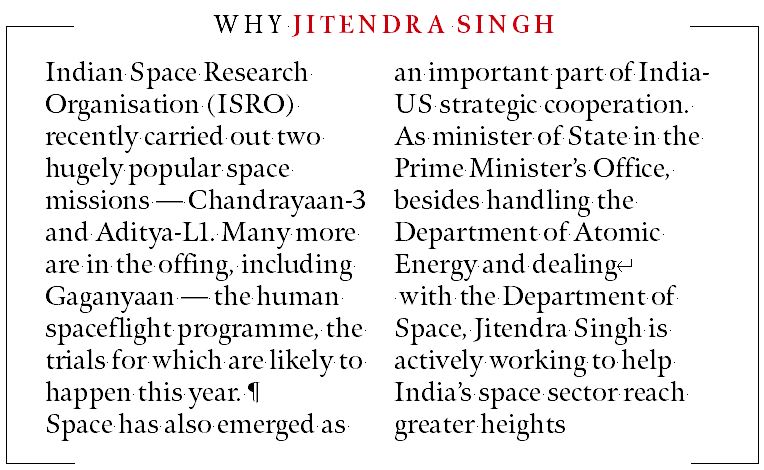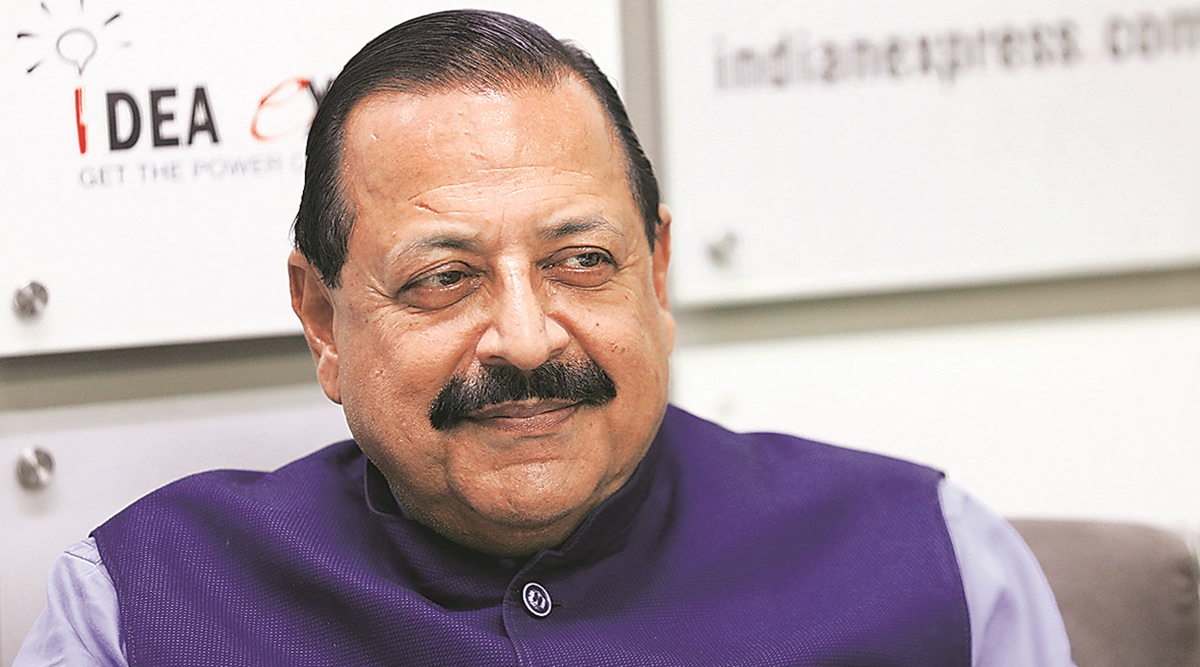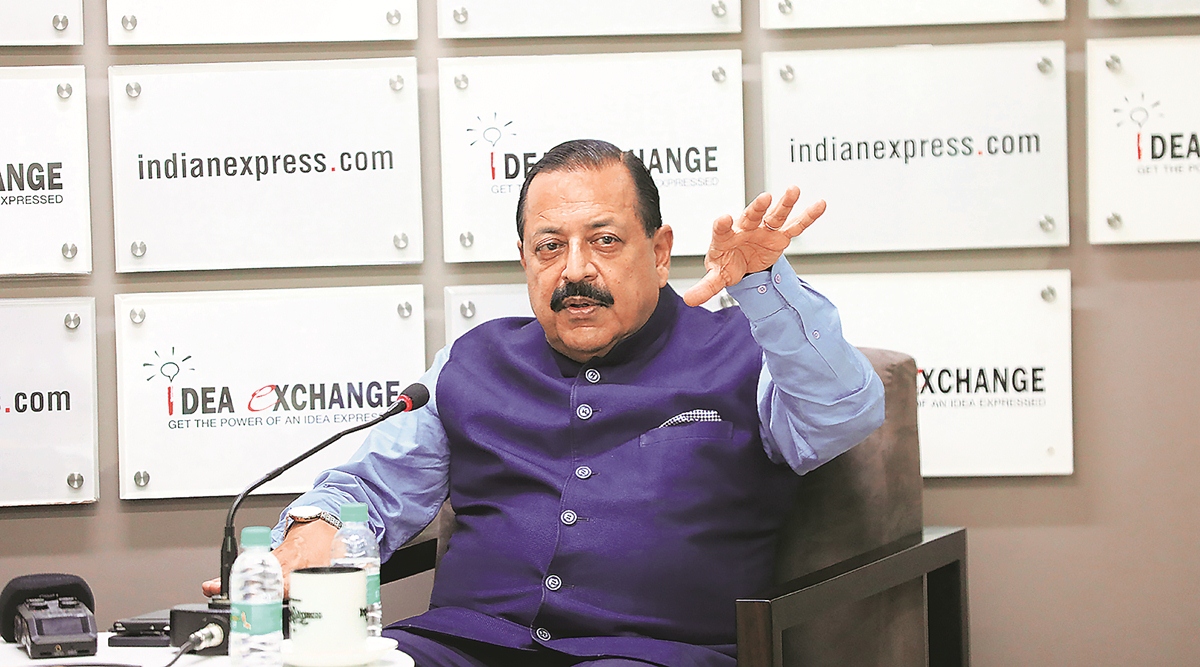Jitendra Singh at Idea Exchange: ‘Space functioned under a veil of secrecy… Now there is synergy between academia, research, industry and startups’
Indian Space Research Organisation (ISRO) recently carried out two hugely popular space missions — Chandrayaan-3 and Aditya-L1.
 "I am not sure when Chandrayaan-4 will actually happen because it’s not been decided yet. Soon we’ll be looking forward to Gaganyaan," Jitendra Singh said. (Express photo by Gajendra Yadav)
"I am not sure when Chandrayaan-4 will actually happen because it’s not been decided yet. Soon we’ll be looking forward to Gaganyaan," Jitendra Singh said. (Express photo by Gajendra Yadav) Jitendra Singh, MoS (Independent) for Science & Technology, on the upcoming human spaceflight programme by ISRO, India’s space ties with Russia and the US and upsurge of violence in Jammu & Kashmir. The session was moderated by The Indian Express Principal Correspondent Anonna Dutt
Anonna Dutt: We’ve seen six-seven space missions by ISRO this year. We might see at least one more important one. What’s made ISRO so prolific?
Now that we have opened up the space sector, all the stakeholders are working together. There’s a huge amount of synergy, which didn’t happen before. There’s the pooling of resources — we have industrial funding, knowledge funding and a good fusion of the young and the old, particularly after 2020. Earlier, we had to function within the limited resources that were available. For almost 60-70 years, there was a kind of status quo — a tendency to carry on the way it was. Everybody had begun to accept that the space department was meant to function under a veil of secrecy. As a result, we were depriving ourselves of pooling from other sources. Governments can’t support space missions in their entirety, which is evident even in premier institutions like NASA, where most of the funding comes from non-government sources. In about three years we have 150 private startups in the space sector. There’s synergy between academia, research, industry and startups.

Anonna Dutt: In the private sector, we have companies like Skyroot and Agnikul, which are developing their own launch vehicles. Do you think we’d see something like SpaceX in India?
The rocket launch presents a very romantic visual. So it’s fascinating and catches the fancy of many. But it is not just limited to launch of rockets. The private startups who are coming forward now are working on a variety of ideas. Some are even looking at scrap — what are the latest concerns due to the many satellites on the horizon and how to clear space pollution. Launching rockets is one small aspect of a huge spectrum where space technology is active in India. Startups are also diversifying.
Sending a human (to space) is important and also romantic. But getting the person back safe is more important. For that, we need to have thorough confidence… We need to have two trial missions before we send a human being in the space
Anonna Dutt: When are we likely to see Chandrayaan-4?
I am not sure when Chandrayaan-4 will actually happen because it’s not been decided yet. Soon we’ll be looking forward to Gaganyaan. After this mission is complete, we will go through the inputs received. Depending on those, a decision would be taken for the next Chandrayaan mission.

Anonna Dutt: What is the new timeline for Gaganyaan, especially when we are talking about a collaborative human spaceflight with the US?
We need to have two trial missions before we actually send a human being. We had planned that the first trial version could happen in October. Earlier, we tried for September but the Aditya mission came up. Sending a human is important and it’s also very romantic. But getting the person back safe is more important. For that, we need to have very thorough confidence. We will send one trial mission, which will follow the same itinerary. It won’t be long, maybe for a few hours going up in this space and returning. The second mission would be by the end of this year, or maybe at the beginning of the next year, which would have a human specimen in the form of a woman robot — Vyommitra. She’ll follow the same itinerary and activity which a human will in the actual mission to make sure that everything goes well. She will be all human except the soul.
Amitabh Sinha: Is there a woman in India’s first team of astronauts?
They have not disclosed that for security reasons.
With the change in the political situation, everybody wants to do business with India. Many countries work with India also because they don’t wish to be associated with China. That could be an advantage for us
Anonna Dutt: There’s been some discontent among scientists with regard to funding of projects, even in the new proposal for National Research Foundation.
The recent complaint was due to some logistical reasons. The finance department had tried to make the modus operandi more transparent by opening up accounts for different projects. So that caused the delay. It’s taken care of. With fellowship grants etc, we’d like to channelise them through the institution so that they reach faster. The National Research Foundation will help with funding. Then we won’t be dependent on just government funds.
Anonna Dutt: Another issue mentioned by the scientists is about problems in procurement. Many high-end equipment isn’t made in India and current procedures cause delays in purchases.
We are more or less indigenous now. Chandrayaan was absolutely indigenous. Ganganyaan is going to be 100 per cent indigenous. There are still certain parts which have to be procured from other countries and there’s no hesitation in doing so. Now, other countries also procure from us. So it’s two-way traffic; we are equal partners.
 Jitendra Singh, MoS (Independent) for Science & Technology. (Express photo by Gajendra Yadav)
Jitendra Singh, MoS (Independent) for Science & Technology. (Express photo by Gajendra Yadav)
Amitabh Sinha: You may not have a date for Chandrayaan-4 right now, but the Chandrayaan programme would definitely continue, isn’t it? It is not going to end with Chandrayaan-3.
Yes, surely. The Chandrayaan decision was taken after a lot of deliberation when Atal Bihari Vajpayee was the PM. It was a conscious decision to have a mission dedicated to the Moon. In those days, there was a worldwide debate — whether to continue these missions or give up. Even though America had landed on the Moon in 1969, they also had second thoughts. Russia, too, was toying with the idea. Finally, they’ve all come back to the race. We’ll have more in the Chandrayaan series but the details will emerge in due course.
Deregulation is now being done in all the departments. Red tapism, from which science was suffering, is being curtailed. Wherever we are coming across issues, we are taking care of them
Story continues below this ad
Amitabh Sinha: You mentioned ISRO cannot be financed by the government alone. What do you mean by that? ISRO has already been doing commercial launches and that brings in revenues. What more does it have to do?
Commercial launchings were happening, including launch of the foreign satellites. But maximum number of them have been in the last eight-nine years. Because our pace has increased, we are launching 100 satellites in a single go. We’ve earned more than $175 million dollars from the American satellites, out of which more than $100 million would have been earned in the last few years. The commercial earnings are now higher. Earlier, we had not opened up the industry to invest in ISRO, or to be private partners, which has started now and is a huge breakthrough.
 Jitendra Singh, MoS (Independent) for Science & Technology. (Express photo by Gajendra Yadav)
Jitendra Singh, MoS (Independent) for Science & Technology. (Express photo by Gajendra Yadav)
Amitabh Sinha: So, if any private company is interested in investing in ISRO, it would be allowed to regardless of whether the company operates in the space sector or not?
That will be on a project-to-project basis. We are already doing something similar in the atomic energy sector. The NPCIL (Nuclear Power Corporation of India Limited) has been allowed to enter into joint ventures with other companies to operate nuclear power plants. Right now, only PSUs are allowed. But in the future, may be we can open it up for the private sector too.
Amitabh Sinha: The Shanti Swarup Bhatnagar Awards for last year have just been announced. Last year, you held back the Bhatnagar awards and other science prizes, and said that the entire awards system would be rationalised. What is being changed?
We did not discontinue the Bhatnagar awards, we decided to rationalise them. The sanctity and value of awards have to be maintained. A coveted award has to remain coveted. So, we will have three big awards now. One is called the Vigyan Ratna Award, which is like a lifetime achievement award. The second would be Vigyan Shri, which will be given to the best project or performance that year. The third would be the Vigyan Yuva Shanti Swarup Bhatnagar award. One should appreciate what Bhatnagar has meant for young scientists.
 Jitendra Singh, MoS (Independent) for Science & Technology, in conversation with Anonna Dutt. (Express photo by Gajendra Yadav)
Jitendra Singh, MoS (Independent) for Science & Technology, in conversation with Anonna Dutt. (Express photo by Gajendra Yadav)
Rakesh Sinha: As a minister and MP from J&K, how would you respond to the complete silence from the leadership on the recent upsurge in violent incidents in the state?
I’m not sure whether we can call it an upsurge, because overall, statistically, things are in control. There’s not been a single incident of stone pelting for the last three years. No crossfires or encounters. The number of tourists last year was about 1.7 crore and this year it’s going to be two crore. Film shootings are happening and cinema halls have opened up. Earlier, militants or terrorists on the run would always look for a soft target and make news. In totality, the number of such incidents has gone down by almost 70 per cent.
Anil Sasi: In the Light Water Reactor Sustainability programme, what is the progress? The Liability Act is seen as a hurdle, isn’t it?
The Liability Act, when it came up, caused a lot of apprehensions, particularly among foreign suppliers. Some of them are still sceptical. We are trying to convince them that all the safeguards are in place. If anything untoward happens, the liability will not directly fall on the supplier. Even if that happens, we created an insurance pool. So, if it goes beyond a certain amount, then that insurance pool will step in and the government will come to aid. But we are certainly moving ahead in making breakthroughs because there’s confidence in India’s capability.
We are also trying to discover our own resources — thorium and water reactors. The biggest breakthrough is with small reactors. To begin with, they could be collaborative and then totally indigenous. We are also engaging in two big joint ventures. One is with the Indian Oil Corporation and the other is with the National Thermal Power Corporation (NTPC). We also need to spread outwards — we were mostly confined to South Indian states, mainly Tamil Nadu and Maharashtra. If we’re trying to look at nuclear energy as one of the sources of clean energy, we need to certainly increase the generation maybe by 2030 or so.
Anil Sasi: Are small modular reactors being looked at as domestic options or is it primarily targeting the export potential?
Both. We are still moving in that direction. Even on the hydrogen front, we have come out with a purely indigenous hydrogen vehicle. Tata had hydrogen automobiles but they were mostly assembling them. National Chemical Laboratory in Pune has come up with something totally indigenous. But we don’t have regulations for running hydrogen automobiles. We may become an exporter of hydrogen one day.
Vikas Pathak: You’d said that terrorists on the run are looking for soft targets. Earlier, mostly civilians used to be attacked. But more recently, there have been many attacks on security forces. They are not soft targets.
This incident that has happened recently was actually an ambush, which sometimes has a different connotation. In the ’90s, there were virtually curfew conditions where people didn’t venture out.
Aanchal Magazine: Do you think the projection of normalcy in Kashmir became too unrealistic and soft targets like Kashmiri Pandits have become easily identifiable? Also, is the terror epicentre shifting from Kashmir to Jammu, Poonch and Rajouri?
For a while there has been a spurt in Poonch and Rajouri. There is one school that says they (terrorists) have shifted, but I think now that has also been taken care of. In proxy warfare, these things happen and these strategies are worked out. As for the projection of normalcy being unrealistic, if that was so, then G20 would not have happened as it did. I think the most popular G20 meeting that happened was in Srinagar. All the hotels were booked. All the side events were there. Leave aside the official routine, people were moving out in shikaras and across the Valley, including all the foreign delegates. There’s a tremendous change. Of course, to make their presence felt, they (the terrorists) did harm the Kashmiri Pandit targets, which, of course, is condemnable. Overall, there is a huge change.
Shubhajit Roy: We are partnering with the US for travel to the International Space Station. Historically, we’ve had closer ties with Russia . Our astronauts also received their initial training in Russia. Are we distancing ourselves from Russia now?
I don’t think so. It’s a multi-aligned world. We are very comfortable with Russia and the collaborations continue with Russia. It’s only that certain priorities even in space have been different. Each country decides its own priorities.
Shubhajit Roy: Has the war impacted the supply chain and, thus, our space programme because of the sanctions on technology?
Yes. One of the reasons for the delay of Gaganyaan is this. When the lockdown happened, the impact was twofold. Our astronauts were undergoing training in Moscow. They had to be called back. And because of the supply chain we were pushed two or three years back. Otherwise, we had a very ambitious plan of launching around the 75th year.
Shubhajit Roy: China has emerged as a tech power globally. Is India, because of its strained ties, a loser in not cooperating with China on technology?
No, I don’t think so. Right from the beginning, we didn’t have much collaboration with China. It was mostly the then Soviet Union. And now, of course, both Russia as well as the US are our partners. With the change in the political situation, everybody wants to do business with India. Many countries work with India also because they don’t wish to be associated with China. That could be an advantage for us.
Amitabh Sinha: Many scientists say that the government talks about bringing in accountability from scientific institutions, which is welcome, but in the garb of it they are being asked to do things that make it difficult for them to do science.
I’ve not come across any scientists who had this feeling. They must get in touch with me, because I like to passionately follow all these issues. But it’s all an echo effect.
Amitabh Sinha: But is there a realisation that some of the processes add to the unproductive work of the scientists. They complain about delays in clearing of funds, increased paperwork, delayed permissions, and general uncertainty. More than one scientist has said that this government doesn’t trust scientists enough.
This government is open to listening to scientists and addressing their concerns. In fact, when we move closer to public-private participation, a lot of these things will be taken care of. Some of the best practices that have been adopted after PM Modi came in were being practised in the private sector. For example, deregulation for drones. There was a rule that you could develop drones only on the premises of an IIT. All drone users and even those engaged in commercial activity would clandestinely find a place in IIT, develop it, and then use in the market. Government has done away with that. I agree that unnecessary regulation not only curtail the initiative but also lead to wastage of resources. But I think this government is very open to addressing these. A whole lot of deregulation is now being done in all the departments. Red-tapism, from which science was suffering, is being curtailed. Wherever we are coming across issues, we are taking care of them.
- 01
- 02
- 03
- 04
- 05































